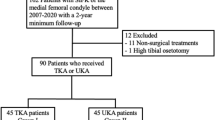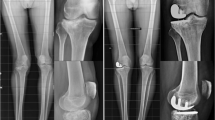Abstract
Purpose
Primary Spontaneous osteonecrosis of the knee (SPONK) was a result of a subchondral insufficiency fracture based on histopathological examinations. There were few studies examining patients who underwent unicompartmental knee arthroplasty (UKA) for the treatment of primary SPONK. The aim of this study was to investigate (1) patient-reported outcome measure (PROM), (2) survivorship of revision as end point and (3) survivorship of complication as end point in patients with primary SPONK.
Methods
The clinical examinations of a consecutive series of 61 medial UKAs for primary SPONK of the medial femoral condyle from 2008 to 2012 were evaluated retrospectively at our institution. There were 18 males and 43 females with a mean age of 73.7 years (60–91). In all patients, preoperative radiographs were analyzed according to the stage of primary SPONK. We conducted Kaplan–Meier survival analyses using revision and complications for any reasons as the end point.
Results
Mean follow-up was 6.6 years (range 6–10). UKA using Physica ZUK (LIMA Corporate. UD, Italy) for SPONK improved patients’ 2011 Knee Society symptom score, patient satisfaction, patient activities, EQ-5D and postoperative ranges of motion compared with their preoperative status (P < 0.01). Revision surgery was required in one knee (1.6%) due to postoperative fracture of the medial tibial plateau after a fall that occurred 6 months postoperatively. The projected rate of survivorship of UKA was 90.4% at 10 years (95% confidence interval 0.80–1). The projected rate of survivorship with complication at end point was 87.7% at 10 years (95% confidence interval 0.76–0.99).
Conclusion
The present study demonstrated that primary spontaneous osteonecrosis of the knee (SPONK) can be successfully be treated with UKA at a mean follow-up of 6.6 years.
Level of evidence
II.




Similar content being viewed by others
References
Ahlbäck S, Bauer GC, Bohne WH (1968) Spontaneous osteonecrosis of the knee. Arthritis Rheum 11:705–733
Yamamoto T, Bullough PG (2000) Spontaneous osteonecrosis of the knee: the results of subchondral insufficiency fractures. J Bone Joint Surg Am 82(6):858–866
Zywiel MG, McGrath MS, Seyler TM et al (2009) Osteonecrosis of the knee: a review of three disorders. Orthop Clin North Am 40:193–211
Myers TG, Cui Q, Kuskowski M et al (2006) Outcomes of total and unicompartmental knee arthroplasty for secondary and spontaneous osteonecrosis of the knee. J Bone Joint Surg Am 88(Supple 3):76–82
Zhang Q, Guo W, Liu Z et al (2015) Minimally invasive unicompartmental knee arthroplasty in treatment of osteonecrosis versus osteoarthritis: a matched-pair comparison. Acta Orthop Belg 81(2):333–339
Heyse TJ, Khefacha A, Fuchs- Winkelmann S et al (2011) UKA after spontaneous osteonecrosis of the knee: a retrospective analysis. Arch Orthop Traum Surg 131(5):613–617
Choy WS, Kim KJ, Lee SK et al (2011) Medial unicompartmental knee arthroplasty in patients with spontaneous osteonecrosis of the knee. Clin Orthop Surg 3(4):279–284
Yamamura K, Minoda Y, Mizokawa S et al (2017) Novel alignment measurement technique for total knee arthroplasty using patient specific instrumentation. Ach Orthop Trauma Surg 137:401–407
Scuderi GR, Bourne RB, Noble PC et al (2012) The new Knee Society knee scoring system. Clin Orthop Relat Res 470:3–19
Brooks R (1996) The current state of play. Health Policy 37(1):53–72
Aglietti P, Insall JN, Buzzi R et al (1983) Idiopathic osteonecrosis of the knee. Aetiology, prognosis and treatment. BJJ 65(5):588–597
Kaplan EL, Meier P (1958) Nonparametric observation from incomplete observations. J Am Stat Assoc 53:457–481
Koshino T (1982) The treatment of spontaneous osteonecrosis of the knee by high tibial osteotomy with and without bone-grafting or drilling of the lesion. J Bone Joint Surg Am 64(1):47–58
Mont MA, Rifai A, Baumgarten KM et al (2002) Sheldon M, Hungerford DS. Total knee arthroplasty for osteonecrosis. J Bone Joint Surg Am 84(4):599–603
Myers TG, Cui Q, Kuskowski M, Mihalko WM, Saleh KJ (2006) Outcomes of total and unicompartmental knee arthroplasty for secondary and spontaneous osteonecrosis of the knee. J Bone Joint Surg Am 88:76–82
Chalmers BP, Mehrotra KG, Sierra RJ et al (2018) Reliable outcomes and survivorship of unicompartmental knee arthroplasty for isolated compartment osteonecrosis. Bone Joint J 100(4):450–454
Parratte S, Argenson JN, Dumas J et al (2007) Unicompartmental knee arthroplasty for avascular osteonecrosis. Clin Orthop Relat Res 464:37–42
Bruni D, Iacono F, Raspugli G et al (2012) Is unicompartmental arthroplasty an acceptable option for spontaneous osteonecrosis of the knee? Clin Orthop Relat Res 470(5):1442–1451
Langdown AJ, Pandit H, Price AJ et al (2005) Oxford medial unicompartmental arthroplasty for focal spontaneous osteonecrosis of the knee. Acta Orthop 76(5):688–692
Heyse TJ, Khefacha A, Fuchs-Winkelmann S et al (2011) UKA after spontaneous osteonecrosis of the knee: a retrospective analysis. Arch Orthop Trauma Surg 131(5):613–617
Sawatari T, Tsumura H, Iesaka K et al (2005) Three-dimensional finite element analysis of unicompartmental knee arthroplasty—the influence of tibial component inclination. J Orthop Sci 23:549–554
Inoue S, Akagi M, Asada S et al (2016) The valgus inclination of the tibial component increases the risk of medial tibial condylar fractures in unicompartmental knee arthroplasty. J Arthroplasty 31(9):2025–2030
Baker PN, Petheram T, Avery PJ et al (2012) Revision for unexplained pain following unicompartmental and total knee replacement. J Bone Joint Surg Am 94(17):126
Acknowledgements
The authors thank Hiroaki Suzuki for his assistance in this study.
Author information
Authors and Affiliations
Corresponding author
Ethics declarations
Conflict of interest
The authors declare that they have no conflict of interest.
Rights and permissions
About this article
Cite this article
Kaneko, T., Kono, N., Sunakawa, T. et al. Reliable patient-reported outcome measure and survivorship of UKA for primary spontaneous osteonecrosis. Eur J Orthop Surg Traumatol 29, 119–124 (2019). https://doi.org/10.1007/s00590-018-2296-6
Received:
Accepted:
Published:
Issue Date:
DOI: https://doi.org/10.1007/s00590-018-2296-6




